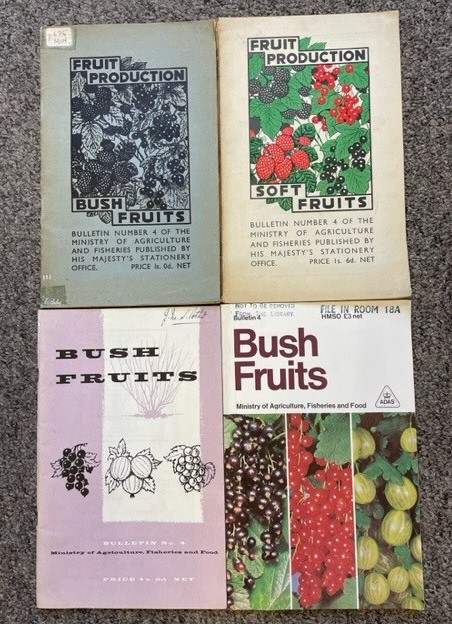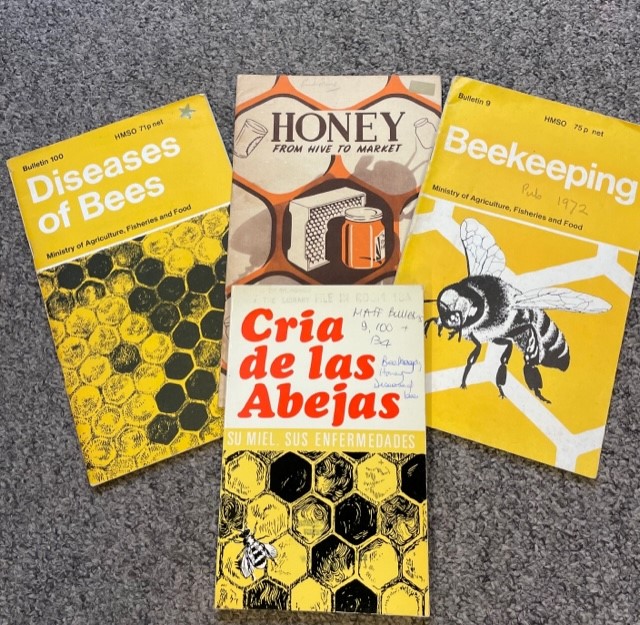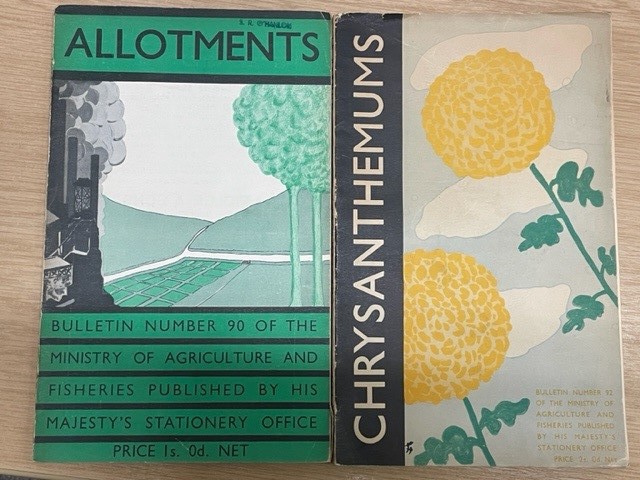Advising the Nation: the MAFF bulletins
Exploring the Ministry of Agriculture, Fisheries and Food (MAFF) bulletin collection at The MERL
Library staff at The MERL have recently completed a project to catalogue over 700 items in the collection of bulletins issued by the Ministry of Agriculture, Fisheries and Food between 1919 and 2002. In this blog, Claudia Ricci, Collections Manager Librarian, explores the history of the publications, picks some highlights and looks at the significance of the collection at The MERL.
The MAFF library is a real treasure trove of official publications, technical reports, regional news bulletins, promotional leaflets and other booklets we might now consider “grey literature”, which were issued between 1919, the year the Ministry of Agriculture and Fisheries (MAF) was founded, and 2002, when its successor, the Ministry of Agriculture, Fisheries and Food (MAFF), was disbanded.
Among the rows of archival grey boxes and black buckram bound volumes a series of colourful booklets stands out, the MAFF Bulletins, which have recently been the subject of a cataloguing project.
The first bulletins were published in 1930 and included core titles such as “Calf rearing”, “Some diseases of farm animals”, “Bee-keeping” and “Edible and poisonous fungi”. Most of these early publications were sizable volumes, already in their 3rd or 4th edition, having previously appeared in the MAF collected leaflet or Miscellaneous publication series. Some have an even longer history, which goes back to the Board of Agriculture and Fisheries that used to issue leaflets on a variety of topics under the heading “Miscellaneous publications” and often consisted of articles reprinted from its own Journal.
Throughout their existence the bulletins were published by HMSO, but their appearance changed over the years mirroring the needs and the aesthetics of the time. Initially available in a choice of unbound (priced at 1 to 3 shillings) or bound volume, either in cloth boards or quarter cloth (priced at around 4 or 5 s.), the bulletins had to adapt to the restrictions of the war years, when they took the form of austere grey paperbacks and effectively abandoned the hardback format. During the 1960s they adopted a more colourful look with a preference for minimalist designs, which was preserved until photography started being used occasionally towards the late 1970s. The identity of the individuals behind the creative cover designs are not known, but some of the covers from the 1960-1970s are quite iconic, particularly those associated with poultry, fruit and flower topics, and clearly reflect the aesthetics of the time and a willingness to keep up with trends in other industries and commercial advertising. The bulletins themselves often include several pages of advertisements, typically targeted at the reader of the volume, whose interests and needs could easily be predicted.

Reflecting the pace of progress
The average print run was about 1,500-3,000 copies in the first decades of production, presumably higher in later years. But what stands out is the frequency at which the bulletins were reprinted, with or without amendments, proving their popularity and the determination to keep them accurate and constantly up to date. There were titles that during a certain period would see a new edition every year or so, such as “Rats and mice” (no. 30) in the 1940s and 1950s, a sign of the problems afflicting the times perhaps, but also an indication of the progress that was taking place in the agrochemical sector, seen that it disappeared after 1953. Others were updated less frequently, such as ones on animal husbandry and fruit cultures, where perhaps the pace of innovation was not as fast. A few titles were abandoned after the first issue, such as “Estate yards” (no. 155, 1952), which perhaps was too ambitious (or general?) in scope, or “Rex-furred rabbits” (no. 73, 1934), which might have been a new breed at the time, but possibly not deserving of an entire bulletin (later included in “Modern rabbit keeping”, no. 50)

Popular titles
Among the top ten most popular titles, we encounter topics that are dear to British farmers and rural households:
-Domestic preservation of fruit and vegetables (no. 21, 13 editions between 1933 and 1977),
-Bee keeping (no. 21, underwent 11 editions, 1930-1972)
-Ensilage (no. 37, 10 editions, 1931-1977),
–Rabbit keeping (no. 50, 10 editions, 1932-1978),
-Soft and bush fruit production (no. 4, issued under various titles in at least 9 editions between 1930 and 1977)

Evolving farming trends
Most bulletin titles underwent various changes in their wording proving that terminology evolves over time even in this conservative sector, reflecting new trends in agriculture and changes in a society that was quickly moving away from the cottage industry of the 19th century, while also highlighting the country’s economic needs. The introduction of new titles also points to the discovery of previously unknown animal diseases and pests, such “Johne’s disease in cattle” (no. 26, 1930s), and innovative methods to control them (“Investigations on celery diseases and their control , no. 25, 1934), or the adoption of recently-developed practices such “Artificial fertilizers in modern agriculture” (no. 28, 1930s) and “Machine milking” (no. 177, 1959). British farmers were encouraged to cast their eye over the Channel and beyond in search of new cultures: “Cultivation and harvesting of sugar beet on the continent” (no 102 in 1936) was followed by “Sugar beet cultivation” (no. 153) in 1953. The introduction of new equipment and technical methods is evident in the popularity enjoyed by titles such “Electric fencing” (no. 147, from 1951 onwards) and “Records and accounts for farm management” (no. 176, from 1958 onwards).

Beyond Britain
Perhaps it’s not surprising that the odd bulletin was translated into Welsh, such as “Diseases of sheep” (no. 170, “Afiechydon defaid”, 1958), and even in Dutch (no. 39, Fertility and animal-breeding), but I find it astonishing that such a quintessentially British publication might have enjoyed great popularity in Spain. Our collection includes 23 titles translated into Spanish that were issued in the series “Manuales de técnica agropecuaria” between 1962-1986. The topics range from poultry management to irrigation, from book-keeping to pig farming including fruit and vegetable cultivation, which is remarkable considering the differences in climate and geographical conditions. This must be a testimony to the advancement of British agriculture in the 1960s and 1970s and the high esteem it which it was held.

All good things must come to an end
Like all good things the MAFF bulletins had to come to an end, but their publication did not cease abruptly. Some popular titles were absorbed in the Reference book series that the Ministry had been publishing since the early 1970s, often in the form of periodicals, a format that lends itself to regular updates; others were incorporated in the various leaflets issued by ADAS (Agricultural Development and Advisory Service), a branch of MAFF. By turning some of these titles into serials MAFF addressed one of the problematic issues associated with the Bulletins, the fact that they had been considered ephemeral literature, deemed to be superseded and replaced with each new edition. And this is what makes the MERL collection of MAFF Bulletins unique, because it preserves different editions and amended reprints for posterity…against the advice that the Ministry would have issued at the time of publication.

Access over 700 publications…
The project of cataloguing the MAFF Bulletins, which includes nearly 700 items, has recently been completed and the various editions and reprints of the 212 published titles are accessible on Enterprise and available for consultation in the MERL Reading Room. Most of this collection comes from the library of the Ministry of Agriculture, Fishing and Food, but there are also items donated by individual donors and acquired by the MERL, which are available for browsing in the open access library.
